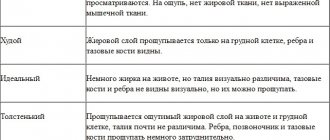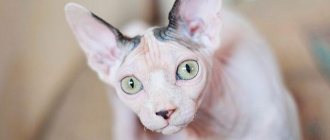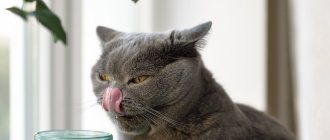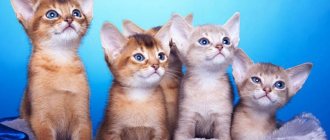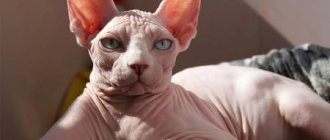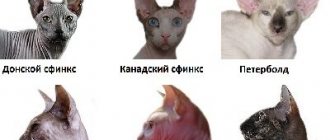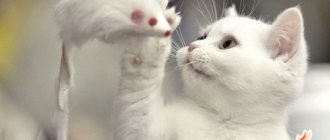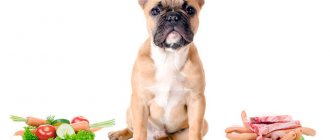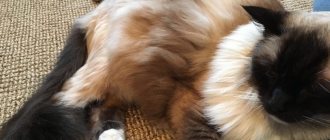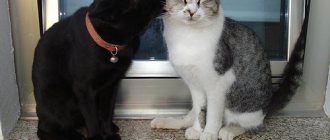The main principles of proper feeding
To feed Sphinxes, you can use both dry and wet food. But regardless of the type chosen, you must remember the following rules:
- The cat should receive a strictly dosed portion. This breed is prone to overeating.
- When choosing a diet, age must be taken into account. Kittens, adult pets, pregnant females and older cats have their own feeding habits.
- Compliance with the regime. The Sphinx must receive food at the same time. In this case, you don’t have to worry about the digestion process, since these cats often suffer from stomach pain.
Thanks to their accelerated metabolism, Sphinxes have an excellent appetite and sometimes eat completely non-cat foods.
Holistic dry food
Industrial feed
The requirements for feeding pets with prepared food - dry or wet - are standard. This:
- Strict adherence to the daily norm. Manufacturers always indicate the serving size on the packaging.
- When choosing food, you need to take into account the age of the Sphinx. For kittens, adult pets, pregnant, spayed/sterilized and elderly cats, we offer our own food that takes into account their age needs.
- Free access to clean water when dry feeding. If the cat drinks little, then forced supplementation or transfer to another type of food is necessary.
It is strictly forbidden for Sphynx cats to be given food below the premium level. In cheap formulations, the source of protein is soy, wheat and corn, but plant proteins are practically not absorbed by the cat’s body. The share of meat components is minimal and of poor quality. As a rule, fat, feathers and offal are used in production.
Natural products
When choosing the option of feeding “natural”, you need to ensure that the nutrition is completely balanced. The cat's menu should include the following products:
- beef and veal;
- chicken offal – neck, heart, gizzards, liver;
- seafood, turkey, chicken - raw;
- steamed fish (cod, salmon);
- boiled egg yolk;
- fermented milk products – cottage cheese, yogurt and others;
- cereals;
- cereals – buckwheat, rice;
- vegetables fruits.
You need to remove all the bones from the fish and grind the meat in a meat grinder.
Recommendations for creating a menu for the week:
- well-frozen and scalded raw beef/veal – daily;
- boiled chicken – up to 4 times;
- boiled/frozen offal - no more than three times;
- porridge (from rice, buckwheat, oatmeal and wheat) - up to three times;
- vegetables, fruits (fresh, boiled) - up to three times;
- sour milk, cheeses – 1 time;
- heat-treated sea fish fillet, egg yolk.
It is recommended to season ready-made dishes with a small amount of vegetable oil, but adding salt or sweetening food is prohibited. In addition, food should be at room temperature.
Vitamin and mineral supplements
If industrially produced food is used to feed the Sphinx, then no additives need to be introduced.
When feeding “natural” food, you must add:
- brewer's yeast - they are suppliers of B vitamins;
- ready-made mineral supplements, for example, Kizim.
The dosage of yeast should be calculated by a veterinarian based on the weight of the cat.
Graceful kitty
Breed Features
Sphynxes combine several breeds of hairless cats. Lack of fur is a mutation fixed by selection . Sphinxes are varied.
Among the breeds there are:
- Fold (Ukrainian Levkoy);
- on short legs (bambino);
- with dog manners (St. Petersburg);
- bald with fur inserts (minskins).
The characteristics of the breed can be seen in representatives of two breeds.
Donskoy
This breed is distinguished by a strong and muscular body with a wide chest. The wedge-shaped head bears tonsil-like eyes and rounded ears. The whiptail may have some hair, but is mostly devoid of it. The limbs are high, the forelimbs are shorter than the hind limbs, thin, but not refined. The toes are large and the feet are powerful.
The skin is soft, delicate, folded, many call it “silk”. The Don Sphynx is divided by type:
- bare (rubber);
- flock (thin, delicate down);
- velor (hair 1-2 mm);
- brush (brush). They do not represent any value, but participate in reproduction.
The breed is characterized by increased sweating. This imposes its own characteristics in skin care and feeding.
Males are larger than females. The average weight of a cat can reach 7 kg, but a cat cannot weigh more than 5 kg. Among Sphynxes, the breed is considered average.
Canadian
If the Don Sphynx is young, the breed is no more than 15 years old, then the Canadian Sphynx is fully formed and stable. The age of the breed is more than 50 years. The baldness gene in this breed, unlike the Don, is recessive. They have no hunger birth, and there are no animals completely not covered with hair.
Body with a well-developed muscle layer. The chest is barrel-shaped, the belly is round. The tail is flexible and thin, similar to a rat's, the proportions are completely preserved. Sometimes a tuft of hair is allowed at the end. The texture of the leather is suede-like. May be covered with fine down.
The weight of an adult cat, as well as a Sphynx cat, varies from 4 to 6 kg. Whatever the breed characteristics of the kitten, it is necessary to feed it in accordance with the requirements of its physiology.
Sphinxes are very diverse. Some of the representatives are slow and lazy, while others are fast, agile, energetic, and playful. The whole lifestyle is reflected on the cat’s body, whose diet needs to be balanced more carefully.
Greater heat transfer (as it is necessary to warm up) and sweating require a higher calorie content in the feed. However, the owner is often concerned about the pet’s overeating and rapid weight gain.
Due to the nature of the breed, the feeding ration should be:
- balanced;
- with a minimum carbohydrate component;
- easily digestible proteins of natural origin;
- optimal amount of fat;
- rich in mineral and vitamin nutrients.
Hairless Canadian or Don kitten at 2 months
Sphynx kittens are adopted at approximately 2 months of age. Until this time, they are breastfed and receive their first complementary foods.
The owner needs to decide on the type of feeding - choose natural or wet food or dry food. If preference is given to the latter option, then special premium and higher class food is purchased, intended specifically for kittens. Before giving, the granules must be softened in advance with water.
Many premium manufacturers offer wet food. The feeding rate is indicated on the packaging.
But for the first days after the move, the kitten continues to be fed what it received at the breeder’s house. A change of place of residence and the absence of a mother is extremely stressful for a pet, and a change in its usual diet will only increase it. New nutrition is introduced gradually. The intestines will be completely rebuilt within a week, and will absorb food that is unusual for it in full.
If the new owner does not know what the kitten was fed by the breeder, then you can follow the standard recommendations. The menu should include:
- ground veal – boiled or well frozen and scalded;
- cottage cheese;
- egg yolk;
- a mixture of meat and vegetables in the form of a pate.
At 2 months of age, a kitten should eat up to 6-8 times a day, in small portions. Therefore, you will have to feed him at night, if necessary. This regimen must be maintained until 4 months of age.
Ragdoll cat breed, description of colors and photos, as well as their character, standards and sizes
The average volume of one serving for a 2-month-old Sphinx is 25 g. It can be increased or decreased. The owner makes adjustments independently, focusing on the physical condition and activity of the kitten.
At the age of 2 - 3 months, calcined cottage cheese, vegetables, spinach, unsalted cheese and sour milk are gradually added to the menu.
It is advisable to give fermented milk as an independent dish, for example, during an afternoon snack.
And the Canadian Sphynx, and the Don, and the Dwelf, and the Cohons, and the Minskin, and the Bambino, and the Ukrainian Levkoy, and the Elf have a sensitive stomach, so all uneaten food should be thrown away immediately so that it does not become a source for the growth of bacteria and the cause of food poisoning.
Clean water, which must be renewed at least once a day, should always be freely available. Otherwise, the kitten may experience constipation and develop dehydration.
Sample menu by age
For kittens, it is necessary to create an approximate menu by age, since the needs of a growing body change every month. During this time, you need to decide on the type of diet and start appropriate complementary feeding.
Up to a month
In the first month of life, the kitten must feed on mother's milk, with which it receives antibodies to form strong immunity. It also helps to balance the colonization of the intestines with microflora.
If natural nutrition is not possible, then the baby is fed artificially. For this, an industrial substitute, diluted goat's milk or infant formula is used.
Feeding regimen for kittens up to a month:
- the first 14 days - every 2 hours (10-12 times a day);
- from 15 to 30 days - every 2-3 hours with a break for sleep (8-9 times a day).
During the first month, it is better for the owner to focus on the kitten’s wishes. If he asks for food, then you need to feed him. The daily portion is from 40 to 60 ml. It depends on the size and health status of the baby.
1 month
At 1 month it is allowed to introduce the first complementary foods, which depends on the chosen diet. Products for natural menu:
- cat milk;
- goat milk diluted with warm water;
- lean meat broth;
- boiled minced meat with a homogeneous structure.
If the owner has chosen a commercial diet, then feeding continues with a cat's milk replacer or infant formula. If there is growth retardation, the kitten is given pate or mousse.
The daily portion depends on the rate of growth and development. The amount of food ranges from 45–50 g to 80–90 g. Feeding regimen is 6–7 meals, excluding liquid food (milk).
2 months
At 2 months, kittens begin to grow stronger and grow faster. Nutrition Features:
- With a natural menu, liquid food (milk, broth) and minced meat remain. New products are being included: fermented milk products, chopped raw beef after preliminary freezing.
- Commercial diets retain cat milk replacer or infant formula. Special canned food for kittens is introduced on an ongoing basis.
The daily portion increases to 65–100 g. The number of meals is reduced to 5–6 times, excluding milk or industrial substitute. At this age, vaccination begins, so a slight weight loss may be observed, which is considered normal.
3 months
When they reach three months of age, kittens begin to be separated into new families. This is accompanied by stress for the pet, so it is necessary to ensure a comfortable transition. It is advisable for the owner to find out what the breeders fed the baby. Innovations in diets:
- The natural menu becomes more varied and nutritious. It is allowed to introduce cottage cheese, quail eggs, raw meat in pieces, grated vegetables (carrots) or apples.
- The commercial diet is supplemented with semi-moist kitten food (pieces in jelly or gravy).
At 3 months, the serving size remains the same (70–100 g), but the calorie content and nutritional value increase. This allows you to extend the saturation period. Number of meals – 5–6 times a day.
Elderly cats
Older Sphinxes play little and prefer to sleep most of the day. And if you don’t limit your daily caloric intake, your cat will begin to actively gain weight. For this reason, the volume of the usual portion is reduced by about 1/3, but this must be done gradually.
The cat's meals should be frequent and in small portions. The menu remains the same.
Elderly Sphynx cats need the following supplements to strengthen their immune defenses:
- vitamin C;
- fish oil – it contains Omega-3 fatty acids;
- vitamins of group A, B, E.
If a cat receives dry or commercial wet food, then it does not need to receive supplements.
Dry food - complete food
How to choose a natural diet
Veterinarians assure that Sphynx cats can be fed both natural food and prepared food, the main thing is that the diet is balanced. However, for hairless cats, natural food is still preferable.
The basis of the diet of a domestic predator should be protein, followed by carbohydrates, and the least amount of fat. Do not forget about a sufficient amount of vitamins, which will have to be added separately to food. Your veterinarian will tell you what specific vitamins and in what quantity.
The diet of a Sphynx cat must include:
- Beef/rabbit meat/poultry meat – daily (alternate);
- Boiled or frozen by-products (heart, kidneys, liver, lungs) - a couple of times a week;
- Cereals - choose those that contain a minimum of gluten (rice, buckwheat, corn grits, millet) - 2-3 times a week;
- Eggs – 1 time per week
- Vegetables and greens (carrots, zucchini, broccoli, spinach, boiled cabbage, etc.) – 2-3 times a week;
- Fermented milk products, cottage cheese, low-fat cheese – once a week;
- Vitamins - daily.
Based on this, it’s easy to create a daily menu for your pet. If you don’t want or have the opportunity to cook every day, you can take minced meat, mix it with vegetables and grains, add a few drops of vitamin D and roll into small portioned balls. You can also add cheese, egg yolk or herbs. Such semi-finished products can be easily frozen and then taken out at the right time and served raw or boiled.
Examples of recommended industrial feeds
Industrially produced food includes components necessary for the full development of a cat. They guarantee a balanced diet, which is what attracts Sphinx owners. Manufacturers offer both dry and wet food.
Dry granulated
The following varieties can be used to feed hairless cats:
- Royal Canin. Designed for pets of all age groups. The manufacturer offers different flavors, as well as specialized foods, for example, for kittens and pregnant/lactating females.
- Hill's Science Plan Adult Lamb. The granules contain the proteins, Omega-3 fatty acids, antioxidants and other components necessary for the cat to strengthen the immune defense, as well as maintain a stable weight.
- Purina Pro Plan Delicate. For its production, only high quality natural products are used.
- Orijen Cat & Kitten. Designed for feeding kittens and adult cats. Contains only natural ingredients. The line offers meat and fish food.
- ACANA Grasslands for Cats. Hypoallergenic, easy to digest, made from natural products. It has a completely balanced composition.
When purchasing, you must track the production date and permissible storage duration.
Wet bagged or canned
To feed Sphinxes, it is recommended to choose the following manufacturers of wet food:
- Leonardo. It has a completely natural composition with a high meat content. Contains complexes of vitamins and minerals.
- Applaws. Made from quality products. The line offers food in different flavors.
- 1st Choice. Hypoallergenic, fully balanced composition. Contains probiotics to improve digestion.
- Almo Nature. Made from high-quality meat or fish, and also includes the necessary components for cat health.
- Grandorf. The food is made from high-quality dietary meat. Hypoallergenic, fully balanced.
The Sphinx has an excellent appetite
What is prohibited and why you can’t eat from the table
Sphynx cats are not picky about food and eat almost everything they can get their hands on with great pleasure. But due to a weak stomach, their diet must be strictly controlled and not spoil the cat with food from your table.
Pets of this breed are prohibited from adding additives such as salt, preservatives, spices and sugar. For this reason, they should absolutely not be given sausages, sausages, canned meat and fish, or fried foods.
Main list of prohibited products:
- cutlets;
- pork in any form;
- chicken bones;
- smoked meats;
- sweets and baked goods;
- meat stew;
- canned fish;
- fresh whole milk, as Sphynx cats often suffer from lactase intolerance.
Eating “human” food causes severe diarrhea in these cats, causes other digestive disorders and provokes dysbiosis.
Is it possible to have different types at the same time?
When choosing food for a cat of this breed, you need to give preference to one type of food: either dry, wet, or natural. It is extremely undesirable to practice feeding two different species at the same time, since the Sphinx’s digestive system is not adapted to rapid adjustment.
If, nevertheless, the decision on a mixed diet is made, then “drying” is offered in the morning, and natural food in the evening. The order can be changed.
Also, you cannot mix “drying” from different manufacturers. Each manufacturer uses their own proportions and ingredients, and also gives specific recommendations on standards. When mixing granules of different compositions, there is no question of a balanced diet.
Stainless steel bowl
Choosing a bowl
The bowl should be comfortable, safe and practical. Ceramics fully meets these requirements. Such bowls are easy to clean and do not slide on the floor when the cat eats.
But ceramics is a rather fragile material. An alternative option is stainless steel cookware. But since metal bowls can slide on the floor, they need to be placed on a special stand.
Better yet, purchase an automatic cat feeder. In this case, you will always be sure that your pet is not only fed correctly, but also on time, even in your absence.
It wouldn’t hurt to add a special automatic waterer to the kit so that the cat is constantly provided with fresh water, filtered from contaminants.
There are differences!
These “naked” cats with an extraordinary, mystical appearance, upon closer acquaintance, turn out to be... lovely creatures with a playful, sociable, inquisitive, very kind and lively character, which you can’t help but love!
An active temperament and lack of a fur coat require an accelerated metabolism! Therefore, to replenish energy costs, sphinxes really love to eat a lot and varied. If they are given freedom of choice in food, they can easily eat not only harmful, but also poisonous, and even... generally inedible. They need an “eye and an eye”, like mischievous children! But they are smart, smart and easy to train, almost like dogs, which allows you to quickly teach “cat-dogs” to order in everything, including food.
Expert advice
In order for your pet to grow up healthy, playful and remain so until old age, you must follow the recommendations of professional breeders. Here they are:
- The cat must eat. Otherwise, due to lack of energy, it will freeze even in a very warm room.
- One drop of vitamin D should be added to the food every day. It is necessary to strengthen bones, as well as maintain normal functioning of the nervous system.
- To remove tartar, sphinxes need not only to brush their teeth, but also to give boiled chicken necks once a month.
- If constipation occurs, fermented milk products are introduced into the pet's menu. To prevent the appearance of hard stools, a little vegetable oil - flaxseed or olive - is added to food.
- Fish is allowed, but not often. It contains a large amount of protein, which can cause the development of urolithiasis. River fish is completely prohibited.
- Seafood can be offered no more than twice a week, having previously selected all the bones from it.
- Both Don Sphynxes and Canadian Sphynxes should not be given whole milk, since the cats’ intestines do not digest lactose.
- It is highly undesirable to practice a mixed diet. To digest dry food granules and natural food, the stomach produces digestive juices of different composition. The food simply will not have time to be digested, and the cat will begin to have problems with stool.
WHAT CAN YOU NOT FEED A SPHINX?
- Raw river fish.
- Fatty pork meat.
- Salty, smoked, sweet and spicy foods.
- Fish or chicken bones.
- Milk, due to the inability to digest lactose.
Remember, if you want to see your pet healthy, forget about treats from the table, feeding your cat pasta with meat or porridge with fish.
